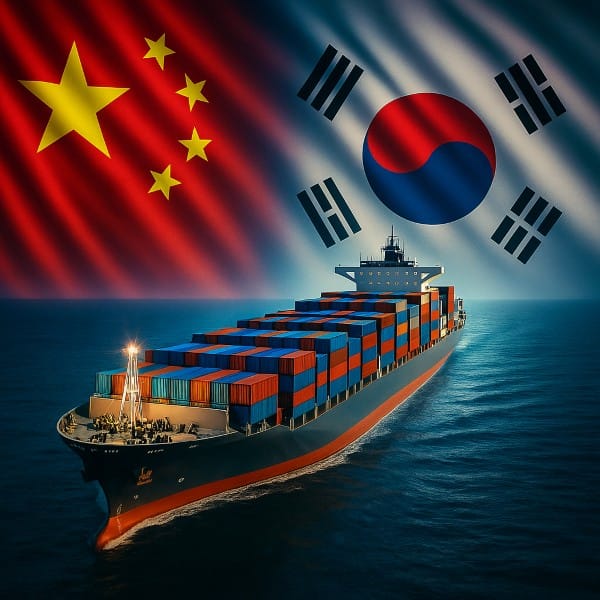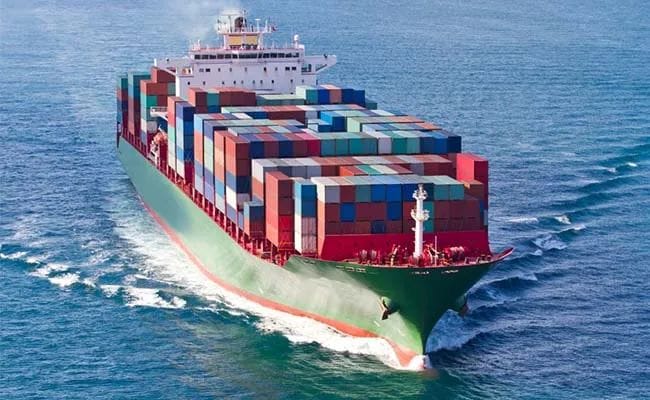China and South Korea have frequent maritime trade. As neighboring countries, the two countries have dense container shipping routes and short voyages, which are the preferred logistics methods for import and export companies. This article will introduce the cost of transporting containers from China to South Korea in detail.

Container Shipping from China to South Korea
Container shipping between China and South Korea is one of the busiest routes in Northeast Asia, and the voyage between major ports is usually 1-3 days. This route has the following characteristics:
- High-frequency liner service: major shipping companies provide fixed liner services daily or multiple times a week
- Dense routes: The busiest routes are from ports such as Shanghai, Qingdao, and Ningbo to Busan and Incheon
- Short transportation time: It usually takes only 1-2 days from eastern ports in China to South Korea, and about 2-3 days from southern ports
- Fierce competition: Multiple shipping companies operate, resulting in relatively transparent and competitive prices
The Difference Between 20ft and 40ft containers
In the field of shipping, 20-foot and 40-foot containers are the two most commonly used specifications in full container transportation. Here are the differences between the two:
| Category | 20ft container | 40ft container |
| Volume | 33 cubic meters | 67 cubic meters |
| Maximum loading weight | 28 tons | 26 tons |
| Applicable scenarios | Heavy goods, small amounts of goods | Large but light goods |
| Freight comparison | Unit freight is higher | Total freight is high, but unit cost is more cost-effective |
Container Cost for Shipping from China to South Korea
Container transport from China to South Korea mainly includes the following cost components:
- Freight (Sea freight): the most basic cost of container transport, usually priced according to the size of the container and the length of the voyage.
- Bunker Adjustment Factor (BAF): an additional fee caused by the fluctuation of fuel prices, which is usually adjusted according to the changes in fuel prices.
- Port charges: including port handling fees, loading and unloading fees, terminal fees, etc. at the port of destination, which vary from port to port.
- Cargo pickup and delivery fees (CFS/CY charges): This includes the cost of picking up and transporting goods from the port to the destination. CFS stands for container freight station and CY stands for container yard.
- Insurance premium: customers need to insure the goods, and transportation companies usually provide insurance services, and the cost is calculated in proportion to the value of the goods.
Cost of Shipping 20ft and 40ft Containers from China to South Korea
Ocean freight from China to South Korea may fluctuate depending on the season, route, shipping company, etc. Since a 40ft container can carry twice as much cargo as a 20ft container, the shipping cost of a 40ft container is usually higher, but the freight rate per unit of cargo may be more favorable.
| POL (Port of China) | POL (Port of South Korea) | 20ft Container Cost | 40ft Container Cost |
|---|---|---|---|
| Shanghai | Busan | $300-$500 | $500 – $950 |
| Shenzhen | Busan | $340 – $550 | $520 – $850 |
| Ningbo | Busan | $300 – $550 | $530 – $990 |
| Shanghai | Incheon | $320 – $600 | $510 – $1000 |
| Shenzhen | Incheon | $320 – $540 | $530 – $950 |
| Ningbo | Incheon | $320 – $550 | $500 – $1050 |
| Shanghai | Gwangyang | $350 – $510 | $520 – $940 |
| Shenzhen | Gwangyang | $325 – $570 | $540 – $850 |
| Ningbo | Gwangyang | $330 – $550 | $520 – $900 |
Read below for container shipping costs to other countries to help you understand more:
Cost of Shipping 20ft and 40ft Containers from China to Japan
Cost of Shipping 20ft and 40ft Containers from China to Canada
Cost of Shipping 20ft and 40ft Containers from China to USA

Factors Affecting Shipping Cost from China to South Korea
Changes in container transportation costs are affected by multiple factors, including:
- Season and market conditions: Costs usually rise during peak seasons (such as before the Spring Festival).
- Cargo type and density: High-density or dangerous goods may incur additional costs.
- Loading location: The farther the factory is from the port, the higher the trailer fee.
- Shipping company and route selection: Prices and timeliness vary greatly among different shipping companies.
- Trade terms (FOB/CIF/DDP, etc.): Costs are allocated differently for different terms.
- Whether customs clearance services or delivery are required: Additional services will increase overall costs.
Goods Restricted from Shipping from China to South Korea
The following are some typical goods prohibited/restricted from entering South Korea:
- Weapons, ammunition and other military supplies
- Counterfeit and inferior products or goods that infringe intellectual property rights
- Undeclared animals, plants or agricultural products
- Toxic chemicals, radioactive substances
- Some medicines, foods, and health products (special approval is required)
- Second-hand electrical appliances, old clothes (need to confirm in advance whether they can be imported)
Customs Clearance for Shipping Container from China to South Korea
After arriving in South Korea, the container needs to complete the customs clearance procedures. South Korea customs supervision is relatively strict, especially, The following are customs clearance documents
Commercial Invoice
Contains description, quantity and value of goods.
Packing List
Details the packaging and loading details of the goods.
Bill of Lading
The transportation contract between the carrier and the shipper.
Certificate of Origin
Document proving the origin of the goods.
Special documents
Licenses, inspection and quarantine reports, etc. may be required depending on the type of goods.
Container transportation from China to South Korea has the advantages of fast transportation time and relatively low cost due to the short distance and frequent flights. Through this article, you can make reasonable choices based on the volume of goods, product type, and additional service requirements. More accurately control logistics costs.
